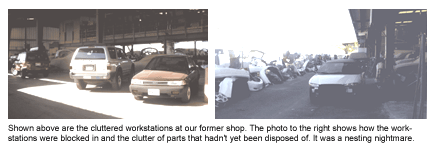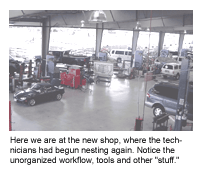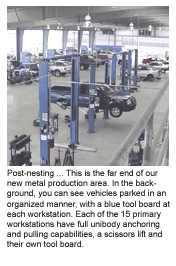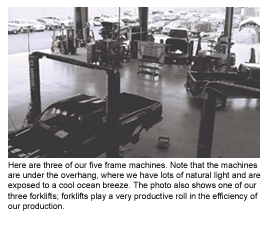Are metal technicians creatures of habit, or does this whimsical tale personify human nature in general?
You decide.
It all started at our original 20,000-square-foot location, from where we recently moved into our new 40,000-square-foot super shop – where this story ends.
At our original facility in past years, our metal department was continually congested with vehicles – a good problem, I’d say. Each one of our technicians had two workstations, one with a lift and the other without. There was a good design flow with easy access to the workstations. The workstations were efficiently laid out with tool boards and, yes, personal “tool boxes” of every size and shape. And what would a workstation be without personal stuff, buckets of used fasteners, radios, calendars, the kid’s toy that needs fixing, obsolete sporting gear and, of course, the reusable parts that are being saved, which never get utilized.

I guess you could say the workstations had evolved – and had become congested with clutter.
As what generally happens within our industry more often than not, workstations evolve into “stalls,” where vehicles sit for one reason or another – usually a parts-related delay. In our situation because of the tight conditions, this meant the technicians’ tool boxes were blocked in, a sort of gridlock.
Fixing cars is what we do, so one way or another, vehicles would be worked on wherever we could find space. The techs would make the best of this situation by moving to where the work would be available, carting whatever tools they felt they needed. They worked well together in this tight environment, supporting and helping one another, kind of like a family.
Through time, we all became very accustomed to this and managed to move vehicles through the system at a reasonably fast pace. As they say, “Necessity is the mother of invention.”
The Move
It was a very exciting time – time to move into the new 40,000-square-foot-facility. We all felt the new shop was like “body shop heaven.”
The metal department, with an abundance of natural light, is designed without walls on three sides and with a 20-canopy overhang. Ten of the 25 workstations are equipped with new scissors floor lifts that elevate a vehicle 4 feet, creating the ideal working condition (research has shown that quality and efficiency increase when standing). Fifteen of the 25 workstations also have unibody anchoring and total pulling capabilities, outfitted with floor pot pulling systems.
Besides the well-equipped workstations, the shop is also outfitted with five drive-on frame racks and five two-post lifts for underbody service work.
All of the workstations are accessible from an access way on either side so vehicles can be moved in and out with ease. So, if a vehicle is delayed, it can be relocated to the vehicle storage area with little effort (usually with a forklift with a wheel-claw system).
Best of all is the working environment – much of the shop has an ocean view. Because of this “open feature,” the entire metal shop usually has a cool ocean breeze that keeps the year-round temperature between 75 and 80 degrees. It’s a tough life …
Anyway … The move went without a hitch. We shut down on a Friday, moved the entire shop over the weekend and were fixing cars the following Monday. What we accomplished was somewhat incredible.
Let the “Nesting” Begin
The technicians didn’t have any reservations finding areas to place their belonging/tools; they all gravitated to a workstation and within a day, had placed their stuff where they felt comfortable. Everyone was a happy camper, fixing cars and making money.
But after several days, I began to notice a phenomenon taking place, though I didn’t quite understand it. I’d begun to see the technicians come together as if there were some powerful force pulling them to one corner of the shop. They had begun to “nest” – organizing (or disorganizing, as I like to put it) themselves as they had been in the old location.
Within days, their toolboxes and shop equipment (welders, parts stands and parts carts) were boxed in. Toolboxes blocked the aisle space between cars, creating a situation where you couldn’t move equipment and toolboxes unless you first moved a vehicle.
And speaking of vehicles, there were vehicles going every which way, facing all directions.
Within days, they’d managed to do what took years to do in the old store – “nest” together in a tight, unorganized manner. What’s most comical is that no one realized what was happening.
When I realized what was going on, I didn’t quite know how to undo it. So I took them all up to the mezzanine to get an overhead view of how their work area looked. But even with this overhead view, not one of them noticed what had taken place. I had expected at least one technician to recognize what I was trying to convey to them. So, as usual, I did all the talking, and they listened – with their heads down.
At first I was disappointed and angry at them, but then I realized that it was my doing. I had failed. It was my responsibility to not only tell them what needed to be done, but to show them how and to redirect them when needed.
I proceeded to explain what and why we did what we did at the old shop and why I thought they were doing the same thing at the new shop, focusing on human nature. I used the word “nesting” several times, and I got a few laughs when I said they were nesting together like penguins on a beach.

I was very frank and stressed the financial commitment I’d made to them – they’re now working in “body shop heaven” and needed to realize it.
The mezzanine meeting was pretty short – about 20 minutes. After that, they all went back to work and continued to nest, although I did begin to see some shuffling around of their stuff.
Out of the Nest
It took several days to move from the nesting syndrome to uncluttered workstations that flowed.

At our daily morning meetings, we continued to discuss how to best set up the workstations, agreeing that each station would be laid out the same, having only “active” tools and equipment – no personal belongings or tools and equipment that are seldom utilized. We also agreed that there could only be one tool box per workstation and that everyone’s tool box would be able to move with ease to any work area throughout the shop. In essence, the workstations would be almost identical, except that each tech would have his own unique tool box.
From there, we continued to improve. Each technician (on his own time) painted parking lines so all the vehicles were centered and facing the same direction. The flow now looks organized and efficient. They all began to see the benefits, both from the organized flow pattern and the increased efficiency it created.

While all of this was happening, our COO, Dale Matsumoto, gave everyone on our entire staff the CD, Who Moved My Cheese? He asked everyone to listen to it while they were driving to and from home and work. The story is about change and was very appropriate.
We discussed how the story related not only to the shop changes that we were going through, but also the impact it had on our lives. The CD helped to make the entire ordeal more palatable and easier to understand. In fact, the whole thing became comical and I, too, began to laugh about it.
Since the “nesting” incident, the technicians have increased their efficiency and have adjusted to “moving with the cheese,” as we all refer to it now. For the most part, they’ve bought into change and wouldn’t want to go back to how things were.
Despite the hassle it caused, it is a funny story.
Nesting – or being comfortable the way things have always been and resisting change – can be very powerful. Now, however, we all agree that change can be a good thing, believing that, “If you always do what you’ve always done, you always get what you always got.”
Writer March Taylor owns Auto Body Hawaii in Kailua-Kona, Hawaii. Not your typical shop owner, Taylor works alongside his employees as a technician. This, he says, gives him “the opportunity to see things how they really are. I’m not disconnected from production or management.”













